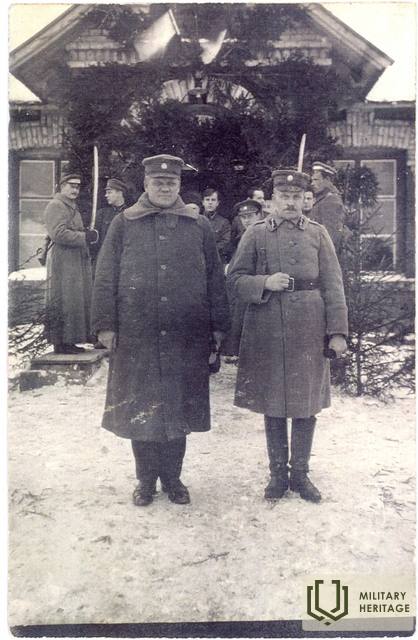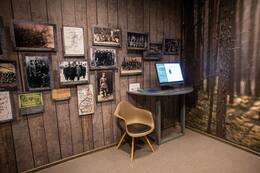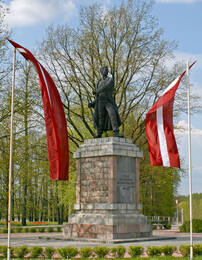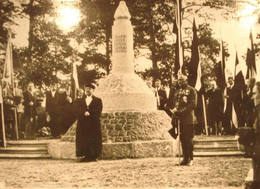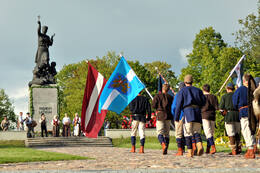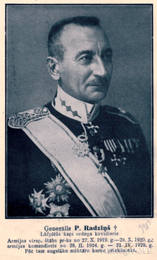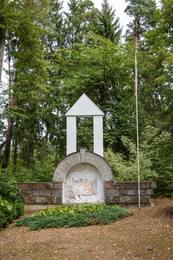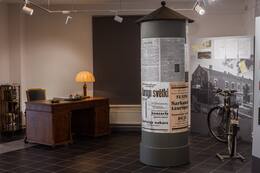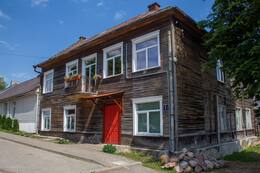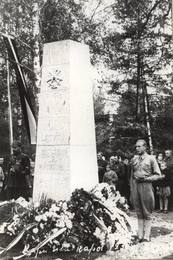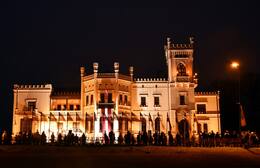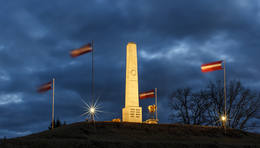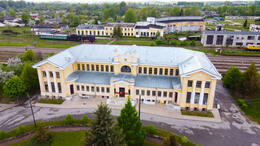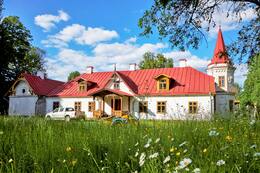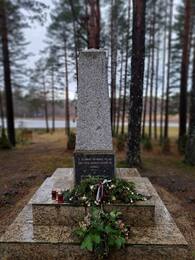Liberation of Latgale from the Bolsheviks
I Wars of Independence
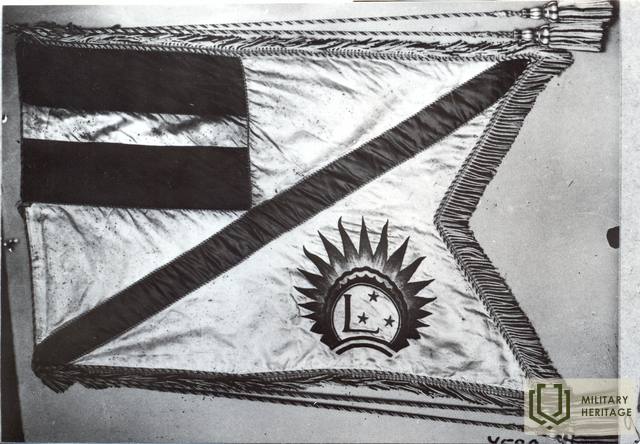
After the victory over the forces of Pavel Bermont, the Latvian government decided on an operation to liberate Latgale, which required the support of neighboring countries. After unsuccessful negotiations with Lithuania, at the end of December the high command agreed on cooperation with the Polish army. On January 3, 1920, Polish and Latvian forces went on the offensive in Southern Latgale, with the Poles liberating Daugavpils, and on January 9, the Latvian army – in Northern Latgale, liberating all of Latgale by the beginning of February.
During the liberation of Latgale, the Commander-in-Chief of the Latvian Army was General Jānis Balodis, and the Chief of Staff of the Commander-in-Chief was Colonel Pēteris Radziņš. The operation to capture Daugavpils was led by Polish General Edvards Ridzs-Smiglijs. The liberation of Rēzekne and the central part of Latgale was led by Lieutenant Colonel Jānis Puriņš, commander of the Kurzeme Division. The operation to liberate Northern Latgale was led by the Latgale Division Headquarters in Vecgulbene, led by Colonel Krišjānis Berķi.
At the same time, in early January 1920, a delegation of the Latvian Red Cross went to Moscow, whose task was to conclude an armistice, which was signed on January 30 (entered into force on February 1). Peace negotiations began in Moscow on April 16, but continued in Riga during the summer, they also depended on events on the Soviet Russian and Polish fronts. The peace treaty was signed in Riga on August 11, 1920.
In April and May 1920, the newly formed Zemgale Division joined the troops on the Latgale Front, while in mid-April, Polish troops left Latvia, remaining only in Daugavpils for the time being. They were forced to leave the city in early July as a result of the Red Army offensive. Then, Latvian forces took over part of the present-day city of Grīva (at that time a separate city on the left bank of the Daugava) and six parishes of Ilūkste County, which had been declared to belong to Poland. Already after the conclusion of peace in early September 1920, the 12th Bauska Infantry Regiment and other units pushed back Lithuanian army units in the Subate district, but in October the Latvian army occupied the last parishes of Ilūkste County, which were left by the Lithuanian army.
More information sources
Ēriks Jēkabsons. Latvian War of Independence. The struggle of the Latvian Provisional Government and its armed forces to ensure the independence of Latvia from 18.11.1918 to 11.08.1920. – National Encyclopedia: https://enciklopedija.lv/skirklis/22216-Latvijas-Neatkar%C4%ABbas-kar%C5%A1
Juris Ciganovs. The liberation of Latgale in 1920 marked the end of the Latvian War of Independence. SARGS.LV, 03.01.2020. https://www.sargs.lv/lv/latvijas-neatkaribas-kars/2020-01-03/latgales-atbrivosana-1920-gada-iezimeja-latvijas-neatkaribas
Liberation of Latgale. Wikipedia. https://lv.wikipedia.org/wiki/Latgales_atbr%C4%ABvo%C5%A1ana
Northern Latgale Liberation Operation. Wikipedia. https://lv.wikipedia.org/wiki/Zieme%C4%BClatgales_atbr%C4%ABvo%C5%A1anas_oper%C4%81cija
Related objects
Exhibition "North Latgale in the Freedom Struggle" at the Balvi Regional Museum
The museum is located in the territory of the Balvi Manor complex, in the building of the former manor barn. The exhibition allows you to look into the history of the Latvian War of Independence from the point of view of Northern Latgale, tracing the history of the formation and activities of the Latgale Partisan Regiment. There are photographs and copies of documents that are not available elsewhere, including the order of 5 July 1919 on the formation of the regiment. The internal orders of the regiment are unique – they were written in Russian between July and October 1919. This reflects the peculiarities of the formation and composition of the regiment as a local unit, where Latvians, Latgalians, Russians, and Jews fought together. The regiment only switched to Latvian in its internal orders after it was fully integrated into the Latvian Army system when it was supplemented by mobilised soldiers from other regions of Latvia. The exhibition also reflects the liberation operation of Northern Latgale, during which the Latgale Division of the Latvian Army liberated the surroundings of Viļaka, Jaunlatgale and Kārsava in battles that lasted from 9 to 15 January 1920. Evidence of both the operation as a whole and the combat activities of the Latgale Partisan Regiment during the liberation of Kārsava are on display in the exhibition.
Preiļi Museum of History and Applied Arts exhibition "Museum Stories for Latvia"
Located in the premises of the Preiļi Cultural Center.
The Preiļi Museum of History and Applied Arts (PVLMM) exhibition "Museum Stories for Latvia" about the First World War, the War of Independence and the Second World War is on display.
The section "The Story of Drywys" of the Preili History and Applied Arts Museum's exposition "Museum Stories for Latvia" (opened in 2018) is dedicated to the First World War, the War of Independence and the liberation of Latgale, as well as the Cavaliers of the Lāčplēšana War Order. The section of the exposition "The Story of the Flag" tells about the complex events of the Second World War, during which the people of Preili were affected by deportations, the Holocaust, involvement in the military units of the warring parties, and after the war - in the ranks of the national partisans. The medal "Righteous Among Nations" awarded to the Preili resident and Jewish rescuer Vladislavs Vuškāns is also on display.
Tours are available in Russian and English by prior arrangement.
Monument to the fallen soldiers of the Latgale Partisan Regiment 1919 - 1920
During the Latvian War of Independence (1918-1920), the Balvi Partisan Division was formed in the Balvi region on the initiative of local residents, which was soon transformed into the Latgale Partisan Regiment.
The idea for a regimental monument arose as early as 1927. In 1933, former Latgale Partisan Regiment soldier and stonemason Jānis Pilmanis built a 5-meter-high stone pedestal for the monument at his own expense. The bronze monument itself was created by artist Kārlis Jansons.
The monument dedicated to the memory of the fallen soldiers of the regiment was unveiled on August 14, 1938, with the participation of General Jānis Balodis. Although the official name of the monument was “Guarding Partisan”, the people soon simply called the monument “Balva Stanislava”.
After Latvia was occupied by the USSR, the monument was demolished in the spring of 1941 by decision of the Abrene County Executive Committee. The high pedestal was demolished, but the bronze monument itself remained in the Balvi police yard.
During the German occupation, the monument's pedestal was not restored, but the bronze monument itself was placed in its previous location. After the second return of the Soviet occupiers in 1944, the monument was completely destroyed.
When Latvia regained its independence, the people of Balvi collected donations for the restoration of the Latgale Partisan Monument. On November 11, 1993, the restored monument by Andrejs Jansons, son of artist Kārlis Jansons, was unveiled in Balvi.
An additional commemorative plaque was added to the back of the monument's pedestal with the text "Renovated also honoring the Latgale national freedom fighters of 1940-1954."
Monument to the soldiers who fell in the Latvian liberation struggle in Yaškovo
Located on the left side of the Viļaka – Vientuļi road section (P35), near the Jaškova cemetery chapel.
Monument to the Latvian and Estonian soldiers who fell in the War of Independence.
The monument, created by sculptor Kārlis Zemdega in memory of the soldiers who fell in the 1920 Liberation War in Jaškovo, was first unveiled on September 22, 1935, at the Viļaka Brothers Cemetery, established in 1929.
The freedom struggle against the Red Army in the Viļaka region began with the attack of the Latvian Army and the Latgale Partisan Regiment on January 9, 1920. Estonian soldiers also participated in it. Viļaka was liberated on January 9, but the fighting to the east of it continued for several more days. Both before and after the liberation of Viļaka, the fallen soldiers were buried in various places known to the local population. As the Latvian state stabilized, people began to think about arranging a common fraternal cemetery in Viļaka. Already on November 18, 1923, after a solemn service in the Catholic church, held by Dean P. Apšinīks, a large procession went to the newly created fraternal cemetery on a hill, in the so-called Jaškovs - in the immediate vicinity of Viļaka. Soon the foundations of the monument were built, and donations for the monument began to be collected. The identification of the graves of the fallen soldiers took time, and only on November 3, 1929, the reburial in the future fraternal cemetery took place. 31 Latvian and 14 Estonian soldiers who fell in the Viļaka area were buried there. In 1935, the monument was ready and it was solemnly consecrated on September 22.
During the pre-war years of Latvian independence, all important national events in Viļaka parish were associated with the fraternal graves and this monument.
The monument was destroyed during the post-war years of Soviet rule, but its granite parts, although damaged, were preserved. The monument was restored on November 11, 1990 - Lāčplēsis Day.
Monument “Vienoti Latvijai” (“United for Latvia”) or Māra of Latgale
The Monument “Vienoti Latvijai” (“United for Latvia”) or Māra of Latgale is located in Rēzekne. Its central image of a woman holding a cross in her hand symbolises the Latgale region of Latvia, which was liberated from Bolshevik rule in 1920, and its spirit of Christian civilisation.
The monument was initiated by public figures of Latgale in the 1920s. The foundation stone was laid and consecrated on 8 June 1930. In June 1934, a competition for the design of the monument was announced, and the design by Kārlis Jansons won the com petition. The monument was unveiled on 8 September 1939, and the consecration service was held by Bishop Jāzeps Rancāns.
After the Soviet occupation in November 1940, the monument was pulled down. The bronze sculptures were not destroyed due to a shortage of time and the monument was restored on 22 August 1943, during the German occupation. When the Soviet occupation returned, the cross was initially sawn off, while, in 1950, the monument was completely destroyed.
During the Soviet occupation, a Lenin monument was erected instead, which was removed immediately after Latvia regained its independence in 1991.
During the Awakening in 1989, the idea of restoring the historical United for Latvia monument was born. The monument was recreated by the sculptor Andrejs Jansons, the son of Kārlis Jansons, in collaboration with Inta Folkmane, based on his father’s materials and photographs. The restored monument was unveiled on 13 August 1992, during the First World Gathering of Latgalians.
Memorial site of General Pēteris Radziņš
Located in Valka parish, driving along the Valka – Rūjiena (P22) road at kilometer 4, turn right, following the signs.
Pēteris Radziņš was born on May 2, 1880 in “Jaunvīndedzēs” of Lugaži parish. He studied at Lugaži parish school, Valka city school and Valka Nelsons real school. He joined the Russian army as a volunteer. In the autumn of 1919, he returned to Latvia and on October 27, he was appointed Chief of Staff of the Supreme Commander of the Army, assuming this position at the moment when the Bermontites threatened Riga. As Chief of Staff, he led all the battles in Riga, Zemgale and Latgale. On February 5, 1920, he was promoted to general.
Nowadays, a memorial stone dedicated to General Pēteris Radziņš (1880 - 1930) can be seen near the family home.
On November 11, 2017, a memorial plaque to Pēteris Radziņš was unveiled in Riga, at the corner of Daugava Gate.
Video: General P. Radziņš memorial event at the Riga Brothers' Cemetery in 2019
Video: On May 2, 2019, on the 139th birthday of General Pēteris Radziņš, a commemorative event was held on the 11th November embankment, near the Presidential Palace, with an honor guard and interested parties surrounding the memorial plaque.
The Valka Museum of Local Lore's exposition "Valka - the Cradle of Latvian Independence" also reflects the life and activities of General Pēteris Radziņš.
In addition to traditional methods of displaying the collection, the exhibition uses interactive multimedia solutions. Information and annotations are translated into Estonian and English.
Monument to the soldiers of the 1st Liepāja Infantry Regiment at the site of the 1919 battles
Located in the village of Meža Strodi, Murmastiene parish, Madona region, 6km from Varakļāni.
The Freedom Struggle Monument can be seen at the site of the battle of the 1st Liepāja Infantry Regiment, where they fought against the “red” army in 1919. Not far from this place, a local resident Aleksandrs Lakstīgala was seriously wounded in battle. He was found dead near a nearby house. That is why the location of this monument was chosen.
On August 16, 1936, a granite Victory Monument (as it was called in the press of the time) was unveiled in memory of the Freedom Struggles, on which the words were engraved: "The place of the battles, sacrifices and victories of the 1st Liepāja Infantry Regiment in Latgale, on August 26, 1919, we bought every corner of our native land with our blood - it is now ours." It was erected by the leadership of the Rēzekne Guards Regiment, consecrated by the senior priest of the Rēzekne Guards Regiment, Vincents Tomašūnas, with the local parish priest Kalinkas. The opening parade was hosted by the commander of the Zemgale Division, Cavalier of the Lāčplēsis Order, Žanis Bachs. In 1950, it was demolished and destroyed. On November 16, 1996, the restored monument was solemnly unveiled, also in honor of the 78th anniversary of the proclamation of the Republic of Latvia.
Exhibition "Latvian Army in Pļaviņas in the 20th Century."
Located at Odzienas Street 2, Pļaviņas.
The permanent exhibition "Latvian Army in Pļaviņas in the 20th Century" is on display.
The building in Pļaviņas, at Odzienas Street 2, has a long history – from the time when the Stukmaņi wholesaler Hugo Apeltofts began active economic activity there, thus contributing to the development of the city of Pļaviņas, to the moment when the headquarters of the Latvian Eastern Front was established here during the War of Independence. In 1919, it was from Pļaviņas that the operations of Latvian army units against the Red Army in Latgale were led.
In 1934, a memorial plaque was unveiled near this house with the inscription: “In 1919, the Eastern Front headquarters was located in this house, and here General Jānis Balodis assumed the supreme command of the Latvian National Army.” The Soviet government removed and destroyed it in 1940, but on June 16, 1990, with the support of the Pļaviņa branch of the Latvian National Liberation Army, it was restored.
Now, near the former headquarters building, there is a memorial stele dedicated to the 15 knights of the Lāčplēsis War Order born in the Pļaviņa region, and an exhibition "The Latvian Army in Pļaviņa in the 20th Century" has been created inside the premises, which tells about the events during the Freedom Struggles, the activities of the headquarters of the 3rd Latgale Division of the Latvian Army in Pļaviņa, and also provides an insight into the life stories of the knights of the Lāčplēsis War Order.
Not far from the exhibition building is the Latgale Division Headquarters building, which was built in 1913 as the Stukmanu liqueur factory by Count Teodors Medem. In 1919, it was taken over by the P. Stučka regime, where it had also established a prison. After the Bolsheviks were expelled, the building was taken over by the Latvian Army in 1925, which housed the Latgale Division Headquarters. 10 generals and other officers of the Latvian Army spent their military careers in this building. In 1940, the building was taken over by the Red Army. In the post-war years, it housed a school, as well as the municipality. Around 1970, the building began to be used by the production association “Rīgas Apērbs”.
Visiting the exhibition must be booked in advance by calling T. 28442692.
Private Exhibition “Abrene Rooms”
The Private exhibition “Abrene Rooms” is located in the town of Viļaka, in a building with a diverse history. Initially, the building was located on the old Marienhausen market square, later it housed apartments, offices and various shops, and during World War II, it was the Latvian self-defence headquarters, the Gestapo and also the Cheka. Several exhibitions reveal diverse events and historical periods in the town of Viļaka and its nearest vicinity covering the time period from 1920 to 1960 when Viļaka was part of Jaunlatgale, later Abrene, district. The exhibit features items from the national partisan camp in Stompaki Swamp, which are related to the national partisan movement in the Latgale region. Documents and photos associated with the War of Independence are also on display. The latest exhibition is dedicated to the once-famous motocross track “Baltais briedis”.
Memorial stele to the Cavaliers of the Lāčplēsis War Order
Located next to the Sacred Heart of Jesus Roman Catholic Church in Viļaka.
A memorial stele for the cavaliers of the Lāčplēsis War Order in Viļaka municipality was unveiled on November 11, 2017. The fates of 28 cavaliers of the Lāčplēsis War Order are linked to the name of Viļaka municipality.
The granite stele was created as part of the project “Remember Lāčplēšis” dedicated to the centenary of the state of Latvia. In honor of the soldiers who fell in the Latvian War of Independence, memorial stele of a uniform model will be installed throughout Latvia. The initiator of the project is the Youth Guard and Information Center.
Five knights of the Lāčplēsis War Order, whose names are engraved on the memorial stele, lived in the territory of the present-day Viļaka district after the end of the War of Independence:
– Jānis Kuļšs was a young farmer in Apsīši, Šķilbēni parish,
– Aleksejs Ľubimovs (Lavrentjevs) lived on the Fortepjanova farm in Šķilbēni parish, later in Viļakas,
– Teodors Mende managed the farm assigned to him and was a forester in the village of Katleši, Žīguri parish,
– Eduards Tenisons lived at the Vecumu station, later lived in the village of Čabatrova and worked at the “Viļaka” post office,
– Jānis Burmeistars lived in Šķilbēni parish for some time after 1928.
The Brothers' Cemetery in Viļaka district is the resting place of 45 soldiers who gave their lives defending Latvia from the Bolsheviks in 1920. January 9 was the day when the attacks began in Northern Latgale, and despite the difficult weather conditions at the time, Viļaka was liberated on the same day.
During the battles for the liberation of Latgale in the Viļaka region, Estonian soldiers fought shoulder to shoulder with Latvian army soldiers and partisans against the Red Army. Many of them gave their lives for a free Latvia.
Alūksne Museum
The Alūksne Museum is located in an architectural monument of national significance: the neo-Gothic Alūksne New Castle built in the late 19th century. The museum features an exhibition named ‘Memorial Room for Victims of the Totalitarian Regime’, which tells about the fate of the inhabitants of Alūksne municipality in Siberia and the Far East, while the time periods from prehistory to the present meet in the Alūksne history exhibit ‘Feast of the Ages’. It features a separate section devoted to the contribution of the 7th Sigulda Infantry Regiment to the military, culture and public life. The formation of the 7th Sigulda Infantry Regiment began on 20 June 1919 in the Naukšēni Manor. Initially, a battle group of 22 officers and 1,580 soldiers was formed from the reserve battalion of the Northern Latvian Brigade, and was named the Dankers Division. It was included in the 2nd Battalion of the 3rd Jelgava Regiment. On 23 August, following an increase in the number of companies, it became part of the 7th Sigulda Infantry Regiment. Having taken part in the battles against Bermondt, on 5 January 1920, the regiment was transferred to the Latgale front to fight the Bolsheviks. After the signing of the Peace Treaty with Soviet Russia, the regiment guarded Latvia’s eastern border. The Latvian War of Independence saw the deaths of more than 200 soldiers of the regiment, while 85 were awarded the Lāčplēsis War Order. In 1921, the 7th Sigulda Infantry Regiment was stationed in Alūksne. The regiment’s headquarters were set up in the Alūksne New Castle. After World War II, the castle was taken over by Soviet security institutions. As of the late 1950s, the castle housed various cultural institutions: the Culture and Cinematography Department of the Executive Committee, a pioneer house, a library, a cinema and a museum.
Monument to the soldiers of the 7th Sigulda Infantry Regiment who fell in the Latvian War of Independence
Located on the shore of Lake Alūksne, on the side of Pskevas Street (Kolberg Street).
On June 22, 1923, the President of Latvia, Jānis Čakste, unveiled a monument to the fallen soldiers of the 7th Sigulda Infantry Regiment. The monument was designed by artist Jūlijs Miesnieks.
The soldiers of the regiment also improved and maintained the area around the monument. The soldiers gathered at the monument on the eve of the regiment's anniversary celebration, when they lit the sacred fire, as well as on the day of the regiment's anniversary after the parade and intercession at the Garrison Cemetery.
In 1940/1941, the Bolsheviks removed and destroyed the plaque, but the monument itself was demolished in 1953 and its stones were built into the corner foundations of the barracks building.
As the Awakening began, the area around the destroyed monument, which was still located in the territory of the USSR occupation troops at the time, was cleaned up in the autumn of 1989. On November 11, a temporary granite memorial was unveiled at the former location of the monument, with the text engraved: "The monument to the 7th Sigulda Infantry Regiment will be restored at this location on November 11, 1989."
Thanks to the initiative of U. Veldre, head of the Alūksne Brothers' Cemetery Committee, restoration work on the monument was begun and the restored monument was unveiled on October 16, 2009.
Unlike the original monument, a cross was created on the obelisk instead of the regimental breastplate. Both reliefs of the monument were forged by sculptor Ainārs Zelčs. Both parts of the 22 original obelisk blocks, which were found on the territory of the Infantry School of the National Armed Forces, and newly made blocks were used for the restored monument.
On June 20, 2019, as part of the centenary events of the 7th Sigulda Infantry Regiment, a memorial site for the regiment's monument and a granite memorial plaque to the fallen soldiers of the unit were unveiled at the foot of the monument hill, engraved with the text: "Your strong spirit always ranks with us...". The memorial site was built with funds donated by the personnel of the Infantry School of the National Armed Forces.
Gulbene Railway Station
The Gulbene Railway Station is located in the city of Gulbene. During World War I, in 1916 to 1917, the narrow-gauge railway line to Pļaviņas was reconstructed to 1,524 mm width to ensure that it can serve as a connection to the Rīga-Daugavpils line. In addition, a railway line to Ieriķi and to Sita was constructed, thereby establishing a connection with Pytalovo. As a result, Gulbene became a railway hub. The current station building by architect Pēteris Feders was constructed in 1926. During the War of Independence, on 31 May 1919, when Gulbene was liberated from the Bolsheviks, the 1st (4th) Valmiera Infantry Regiment collected a significant number of war trophies here. On 14 June 1941, both civilians and Latvian Army officers arrested in the Litene Summer Camp were deported from the Gulbene Railway Station. As a key hub, it was bombed in the spring of 1944. After the war, it was restored to its original form. An educational and interactive centre named ‘Railway and Steam’ was opened in 2018. Next to the Gulbene station is the company SIA Gulbenes – Alūksnes bānītis, which offers interactive lessons and tours. Visitors have access to the station building and platform, a memorial plaque and a monument to the repressed ones by sculptor Indulis Ranka.
Arendole Manor
Arendole Manor was first mentioned in historical sources in the 16th century. Over the course of time, the owners of the manor have changed several times. The manor has belonged to the Grappenbruck, Lydinghausen-Wulf and Plater-Zyberk families. The manor house received its current look during the reconstruction between 1895 and 1901. On 14 January 1921, on the basis of the agrarian reform law, the manor was expropriated and put at the disposal of the Kalupe Parish Board. The landlord house building of the manor was renovated and, in 1925, a primary school and an orphanage were founded there, while the home for the disabled of the war was established in the building of the servants’ house. The school and the home for the disabled were operating until 1975.
In 1995, the building of the Arendole Manor landlords was purchased by private owners and its restoration began. Since 2002, the association “Es Latgalei” (I am for Latgale) has been operating at the manor, which is taking care of its preservation and development.
The visitors to the manor have the opportunity to see the renovated premises and get acquainted with the largest collection of ancient objects in Latgale, as well as to learn about the historical events of the 20th century in Latgale. A special exhibition is dedicated to Jānis Babris, the former policeman of Kalupe Parish (1904–1982), who, on 14 June 1941, resisted a deportation task force, shot a militia operative, Slics, and wounded Communist Party plenipotentiary, Jozāns.
Arendole Manor offers overnight stays and rental space for various events.
Monument to the Latvian Freedom Struggles at the site of the battles of the 3rd Jelgava Infantry Regiment
Monument to the 3rd Jelgava Infantry Regiment's January 16, 1920, freedom struggle in Latgale. With the inscription: “The place of the 3rd Jelgava Infantry Regiment's battles, the victory march through Latgale. 1920.16.I. We brought the sun, freedom and independence to Latvia”
The monument was unveiled in 1936. On August 16, General Žanis Bachs (1885–1941) consecrated it by Pastor Ādams Vizulis (1891–1970). The author of the monument's design was Engineer Zilēvičs.
The Latvian War of Independence (1918–1920) operation to liberate Latgale began on January 3, 1920. By mid-January, the Latvian and Polish armies had liberated Daugavpils and most of southern Latgale up to the Dagda–Indra line from the Bolshevik forces that had seized power in Russia. On January 9, the Latvian army began its offensive in Northern Latgale, rapidly advancing towards the Kārsava and Pitalova stations.
In the middle between the two directions of attack remained the Bolshevik-controlled area around Varakļāni, Viļāni and Rēzekne. On January 20, Latvian army units began the operation to liberate Rēzekne. Rēzekne was liberated on January 21. The Latvian army, across the entire expanse of the Eastern Front, reached the border of Latvian-inhabited lands by the end of January. Already on February 1, Soviet Russia signed an armistice agreement with Latvia.
With the victory in the Battles of Latgale, Latvia's eastern border was secured and the opportunity to annex Latgale to Latvia was gained. The Latvian army achieved the final unification and independence of Latvia in 1920.
The monument, dated 1920.16.I., is dedicated to the moment when the 3rd Jelgava Infantry Regiment took up its starting positions before the operation to liberate Rēzekne.
Memorial plaque to General J. Balodis
In July 1919, the headquarters of the Kurzeme Division moved to Pļaviņa. Soon, the headquarters of the entire Eastern Front was established in Pļaviņa and its leadership was entrusted to Colonel Jānis Balodis. J. Balodis was appointed Commander-in-Chief of the Latvian National Army on October 16, 1919.
On June 17, 1934, a memorial plaque was unveiled with great festivities and a parade. The plaque reads: "In this house in 1919, the headquarters of the Eastern Front was located, and here General Jānis Balodis assumed the supreme command of the Latvian National Army." General K. Berķis and the Prime Minister's Deputy M. Skujinieks participated in the unveiling of the memorial plaque, saying: "I unveil this plaque as a blessing to our people, and I hand it over to the public for safekeeping and protection." Before that, the mayor of Pļaviņa, P. Lacītis, gave a short speech. The plaque was consecrated by the pastor of the Koknese and Pļaviņa congregations, Rozenbergs, speaking in lovely, heartfelt words about the duty of citizens to the state. The Holy Scriptures say: If God is with us, who can be against us. – There were many enemies at the cradle of the new Latvia, but God was with us, God was with the righteous cause of Latvia and raised it in the sun. Now Latvia has been restored, it needs a new spirit. We do not need to ask – what does Latvia give us, but – what can I give you, the dear land of our fathers? On this memorial plaque we have written the name of a man who, with God's help, did great things. May we all have a common goal: With God for the new Latvia!
At that time, the newspaper "Latvijas kareivis" (19.07.1934. No. 133) wrote about the great event:
"A beautiful, sunny Sunday morning fills the small town. National flags flutter on all the houses, a festive feeling is everywhere. Even the rustling of the Daugava on the mighty rocky banks, like solemn music, joins the festive mood. Pļaviņas celebrates a great holiday - the 15th anniversary of its liberation and honors the commander-in-chief of our army and current Minister of War, General J. Balodi, by unveiling a memorial plaque at the house where the great leader of our army and his headquarters lived."
Related stories
Liberation of Northern Latgale from the Bolsheviks
On December 1, 1918, the Red Army units, based on the Red Riflemen units, invaded the territory of Latvia. In order to protect their homes, families, native region and escape from terror, the men of the Balvi area took up arms and went into the forests, the formation of the first “green” groups began. In the spring of 1919, when mobilization was announced, many men of the Balvi area found fighting in the Soviet Latvian Army unacceptable and joined the “green” groups. The Balvi, Silakrogs, Rugāji, Teteru-Dūrupe and Liepna groups were formed. The activities of the “green” groups in the Balvi area became more active in March 1919.
In memory of Pēteris Radziņš, general of the Latvian Army, two-time Cavalier of the Lāčplēsis War Order
General Pēteris Radziņš was born in Lugaži parish, Valka district, into a simple farmer's family, where he learned to do field work. He was a very smart young man, after graduating from school he decided in favor of war and thus began his army career, saving Latvia from Bermont's troops. P. Radziņš was one of the most outstanding officers of the Latvian army and was awarded numerous Latvian and foreign orders and commemorative signs.




